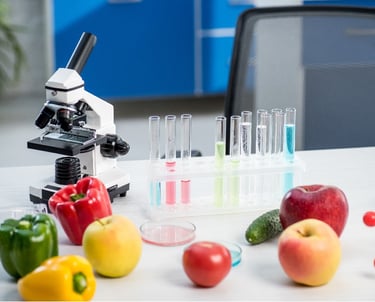
FOOD ANALYSES AND TESTS
Food analyses and tests are scientific examinations and evaluations conducted to determine the safety, quality, nutritional value, and compliance with legal regulations of food products. These analyses can be applied at every stage of the food production chain (from raw material to finished product) and play a critical role in ensuring that consumers have access to safe and reliable food.
Food analyses and tests can generally be categorized as follows:
1. Chemical Analyses:
Nutrient Analysis: Determining the amount of macronutrients (protein, fat, carbohydrates) and micronutrients (vitamins, minerals) in foods.
Food Additive Analysis: Detecting and quantifying additives used in foods, such as preservatives, colorants, and sweeteners.
Residue Analysis: Detecting and quantifying chemical residues in foods, such as pesticides, herbicides, veterinary drugs, and heavy metals.
Toxin Analysis: Detecting and quantifying natural toxins in foods, such as mycotoxins (toxins produced by molds) and seafood toxins.
Water Activity and pH Analysis: Determining the water activity and pH values, which affect the risk of spoilage and shelf life of foods.
Fatty Acid Profile: Determining the types and amounts of fatty acids in the fat content of foods.
2. Microbiological Analyses:
Total Bacterial Count: Determining the total amount of viable bacteria in foods.
Pathogen Analysis: Detecting and quantifying pathogenic bacteria that can cause food poisoning, such as Salmonella, E. coli, Listeria monocytogenes, and Staphylococcus aureus.
Yeast and Mold Count: Determining the amount of yeast and mold that can cause spoilage in foods.
Hygiene Control: Taking samples from surfaces and air to assess the hygiene status of the production environment and equipment through microbiological analyses.
Shelf Life Tests: Tests conducted to determine how long foods can last before spoiling microbiologically.
Sterility Tests: Checking whether heat-treated foods, such as canned and UHT products, are sterile.
3. Physical Analyses:
Color, Odor, Taste, and Appearance Analysis: Evaluating the sensory properties of foods.
Texture Analysis: Measuring the textural properties of foods, such as hardness, crispness, and elasticity.
Foreign Material Detection: Checking for the presence of foreign materials in foods, such as stones, glass, and metal fragments.
Particle Size Analysis: Determining the particle size distribution of ground or powdered foods.
Packaging Integrity Tests: Checking the properties of packaging, such as sealing and durability.
4. Genetic Analyses:
GMO (Genetically Modified Organism) Analysis: Determining the presence and quantity of genetically modified components in foods.
Species Identification: Determining the animal species from which meat and meat products are derived (e.g., detecting whether horse meat has been substituted for beef).
Allergen Analysis: Determining the presence and quantity of allergenic proteins, such as peanuts, soy, and gluten, in foods.
5. Radiological Analyses:
Measuring the level of radioactivity in foods (particularly important after nuclear accidents).


Reliable and Comprehensive Solutions in Food Analysis: Why Choose Kompass Europe?
Food safety and quality are more important today than ever before. Consumer expectations are rising, legal regulations are becoming stricter, and competition is increasing. In this environment, choosing the right laboratory for food analyses and tests is a critical factor for your success. Here are some compelling reasons to choose Kompass Europe:
Comprehensive Range of Analyses and Expertise
Latest Technology and International Standards
Fast, Reliable, and Traceable Results
Customer-Focused Approach and Customized Solutions
Reliability and Impartiality
Continuous Support and Consulting
Contact Us for Food Analysis and Testing.
We offer affordable and effective solutions tailored to your needs.
The information presented on this website does not constitute legal advice and is intended for informational purposes only. KompassEurope.com.tr assumes no responsibility for any errors or omissions in the information contained on this website. Any decisions made or actions taken by the reader based on this information are solely at the reader's own risk, and KompassEurope.com.tr shall not be held liable for any legal consequences arising from such decisions or actions. Readers are strongly advised to seek professional legal counsel regarding their specific circumstances and concerns.
© 2025 Kompass Europe. All rights reserved. The contents of this website belong to Kompass Europe and are protected by copyright laws. Copying, publishing, distributing or any commercial use of the information on the website is possible only with written permission. By using this site, you agree to our Terms of Use and Privacy Policy.
